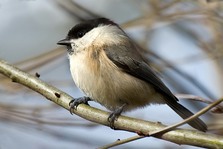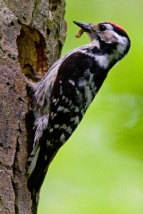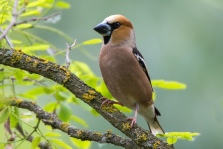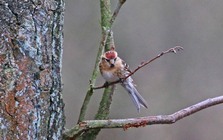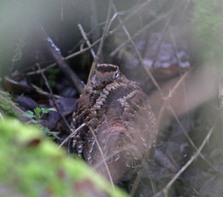

Biodiversity
Action
Plan
Five Woodland Local Priority Bird Species
In common with the rest of the country, birds heavily reliant on woodland for food, breeding and roosting, such as Lesser Spotted Woodpecker, Spotted Flycatcher and Willow Tit, have severely declined in numbers, as have Lesser Redpoll and Woodcock.
Willow Tit, a thick-necked tit, has a black bib and cap, and a pale wing panel.
It is local in distribution in Barnsley with 20-60 breeding pairs,now possibly declining and vulnerable to loss of habitat.
It is found in wet woodland and damp scrubby areas often along streams and former railway lines.
In summer it feeds largely on invertebrates, in winter it takes seeds and may use feeders.
Conservation measures
- Maintaining early successional wet woodland as well as dense damp scrub.
- Retaining standing deadwood & decaying small-girth trees
- Strapping deadwood to trees and leaving decaying small-girth tree stumps
- Avoiding disturbance
RSPB advice BftB project [links]
Habitats
- Wet Woodland
- Scrub
- Previously Developed Land with scrub
Each year Willow Tits excavate a new nest hole in standing deadwood and decaying small-girth trees, the only tit to do so.
Willow Tits establish territories from January and breed from April to June. They remain in their territories from year to year.
Its decline is due to habitat loss, and fragmentation, lack of invertebrate food, predation by Great Spotted woodpecker and competition by other tits.
A Back from the Brink project has focused on Willow Tit in the Dearne Valley.
Willow Tit - more
UKBAP 2007 Priority Species
NERC Section 41 Species of Principal Importance
BoCC5 Red List [IUCN2 EN]
General protection W&C Act
Lesser Spotted Woodpecker is sparrow-sized, with black wings with white bars and a white breast with dark streaks; males have a red crown.
Scarce and local in Barnsley, at less than 20 breeding pairs.
It feeds on larvae, spiders and wood-boring insects on smaller branches high in the tree.
It prefers mature, deciduous trees with decaying branches.
Conservation measures
- Woodland management leaving decaying trees for nest sites and invertebrate food
- Measures to reduce predation and competition
- Monitoring of known sites
Habitats
- Wet Woodland
- Mixed Deciduous Woodland
- Potentially:
Parkland; Orchards
It excavates its own nest hole, usually in decaying wood in branches of trees.
It breeds from late April to late May with a single brood which fledges in July. They often remain in their territories year to year.
Its decline may be due to increased competition from the Great Spotted Woodpecker, as well as lack of food availability, predation and loss of mature trees with decaying wood.
Lesser Spotted Woodpecker
UKBAP 2007 Priority Species
NERC Section 41 Species of Principal Importance
BoCC5 Red List [IUCN2 VU]
General protection W&C Act
Lesser Redpoll, small streaky-brown birds with a tiny beak, red forehead (poll) and black bib, can be seen upside down in tall trees feeding on seeds.
Scarce and local in Barnsley, it is found mainly in upland areas with birch, alder and sallow, as well as young conifers. With around 20 breeding pairs it has declined in recent years.
Lesser Redpolls mainly feed on small tree seeds, as well as weed seeds.
Conservation measures
- Re-stocking upland conifer plantations
- Conserving birch and alder woodland and mixed scrub.
- Maintaining weedy grassland and verges
Habitats
- Mixed woodland
- Young confer plantations
- Birch scrub
- Wet woodland
Redpoll breeds from late April to July, with up to three broods. Up to six pairs may nest together in loose colonies.
They build their nests in trees or bushes as an untidy cup of fine twigs, grass, and plant stems with a lining of plant down, feathers and hair.
Their decline may be due to drops in breeding success and survival rates, perhaps linked to smaller areas of suitable habitat and a lack of available seeds.
Redpoll (Lesser)
UKBAP 2007 Priority Species
NERC Section 41 Species of Principal Importance
BoCC5 Red List
General protection W&C Act
Woodcock, a bulky bird with short legs and a long straight bill, is most active at dawn and dusk. Brown with black and grey barring, they hide away in dense cover during the day.
It is found in woodland and nearby heath which have damp areas for foraging.
It feeds by probing its bill into damp ground, eating mainly earthworms and beetles, as well as other invertebrates.
Conservation measures
- Woodland management to maintain both wet areas for feeding and drier areas for shelter and nesting
- Avoiding disturbance during the breeding season
- No shooting before December or where numbers are low
Habitats
- Mixed deciduous woodland
- Wet woodland
- Heath near woodland
Woodcock have nests in hollows on the ground in bracken or dead leaves. They breed from early March to mid-July with one or two broods.
Males undertake display flights (roding) over tree lines. Less than 50 roding males are found in Barnsley.
Woodcock decline may be due to loss of woodland, woodlands drying out, declining woodland management, maturing of new plantations and disturbance.
Woodcock
BoCC5 Red List [IUCN2 VU]
Game Bird Act
General protection W&C Act
Hawfinch,a large orange-brown finch with massive head and powerful bill for cracking seeds.
They are found in mature broadleaved woodland with open glades.They spend most of their time in the woodland canopy
In Barnsley Hawfinch have bred in Stainborough but they may have declined to the extent that they no longer breed here.
Conservation measures
- Maintain suitable habitat of mature broadleaved woodland rich in large seeds.
- Leave hedgerows uncut to provide berries over-winter
Habitats
- Mixed deciduous woodland
They feed on seeds, buds and shoots. The Hawfinch has its nest usually high up in trees
Possible causes of its severe decline include low nesting success; a shortage of over-winter food and changes to its habitat. In addition it may suffer from predation.
Hawfinch
UKBAP 2007 Priority Species
NERC Section 41 Species of Principal Importance
BoCC5 Red List [IUCN2 EN]
General protection W&C Act
